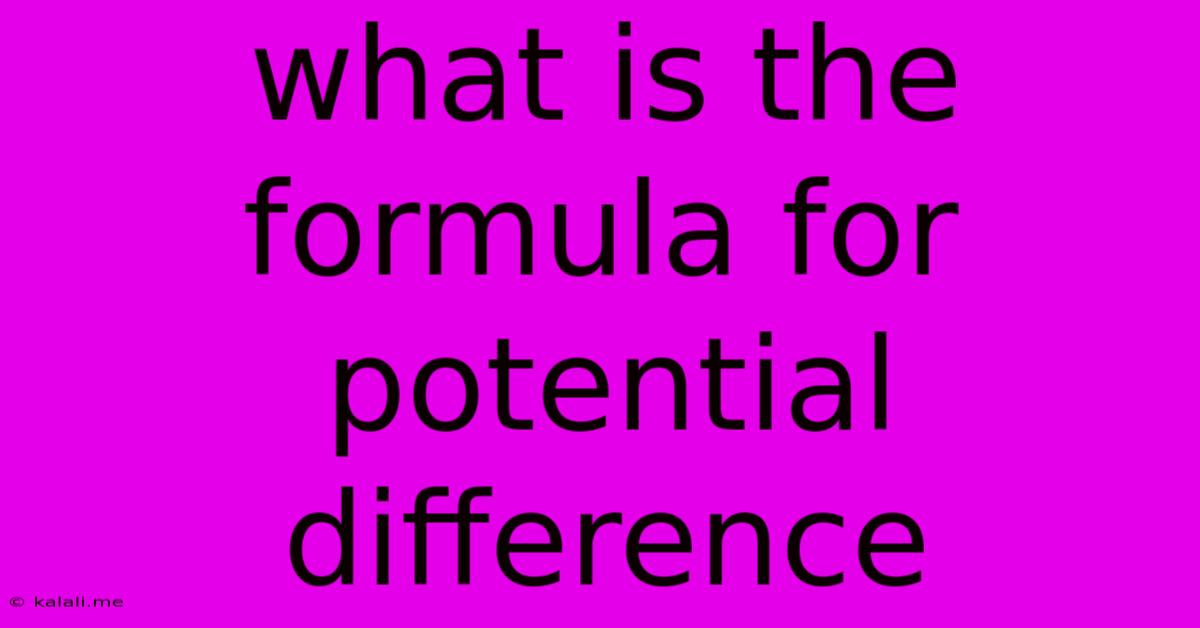What Is The Formula For Potential Difference
Kalali
Jun 11, 2025 · 3 min read

Table of Contents
What is the Formula for Potential Difference? Understanding Voltage and its Calculation
Potential difference, more commonly known as voltage, is a fundamental concept in electricity. It represents the work done per unit charge in moving a charge between two points in an electric circuit. Understanding the formula for potential difference is crucial for grasping how electricity flows and how circuits function. This article will explore the formula, its application, and related concepts.
What is Potential Difference?
Imagine a hill. The higher you climb, the more potential energy you gain. Similarly, in an electric circuit, the potential difference represents the "electrical pressure" that pushes electrons from a point of higher potential (higher energy) to a point of lower potential (lower energy). This "pressure" drives the flow of electric current. The unit of potential difference is the volt (V), named after Alessandro Volta.
The Formula for Potential Difference
The formula for potential difference (V) is:
V = W/Q
Where:
- V represents the potential difference in volts (V).
- W represents the work done in joules (J). This is the energy required to move the charge.
- Q represents the charge in coulombs (C). This is the amount of electric charge moved.
This formula essentially tells us that the potential difference between two points is directly proportional to the work done and inversely proportional to the charge moved. The more work required to move a charge, the higher the potential difference. Conversely, the larger the charge moved, the lower the potential difference for the same amount of work.
Understanding the Components:
-
Work Done (W): This refers to the energy transferred to move the charge. It's measured in Joules (J) and represents the amount of effort needed to overcome the electrical forces between the charges. Think of it as the "electrical effort".
-
Charge (Q): This is the quantity of electricity being moved. It's measured in Coulombs (C). One Coulomb is a large amount of charge, equivalent to the charge of approximately 6.24 x 10<sup>18</sup> electrons.
Applications of the Potential Difference Formula
The formula V = W/Q has widespread applications in various electrical calculations and circuit analysis. It’s essential for:
-
Calculating the voltage across a component: Knowing the work done and the charge moved allows us to determine the voltage drop across a resistor, capacitor, or other circuit element.
-
Determining the energy consumed by a device: By rearranging the formula (W = VQ), we can calculate the total energy consumed by an appliance given its voltage and the charge it uses.
-
Understanding Ohm's Law: The formula for potential difference is closely related to Ohm's Law (V = IR), which connects voltage, current (I), and resistance (R). This provides a crucial link between potential difference and the flow of current in a circuit.
-
Analyzing complex circuits: In more complex circuits, the formula helps in calculating voltage drops across different branches and components, allowing for a thorough understanding of the circuit's behavior.
In Conclusion:
The formula V = W/Q provides a fundamental understanding of potential difference, a cornerstone concept in electrical engineering and physics. By understanding this formula and its components, we can better analyze and predict the behavior of electrical circuits and devices. Its applications extend far beyond simple calculations, providing a crucial tool for comprehending the intricate workings of electricity.
Latest Posts
Latest Posts
-
How Long Ago Was The 16th Century
Jul 01, 2025
-
How Many Inches Are In 4 Yards
Jul 01, 2025
-
How Many Calories In A Pound Of Hamburger
Jul 01, 2025
-
How Many Ounces Are In 9 Pounds
Jul 01, 2025
-
What Kind Of Room Has No Doors Or Windows
Jul 01, 2025
Related Post
Thank you for visiting our website which covers about What Is The Formula For Potential Difference . We hope the information provided has been useful to you. Feel free to contact us if you have any questions or need further assistance. See you next time and don't miss to bookmark.